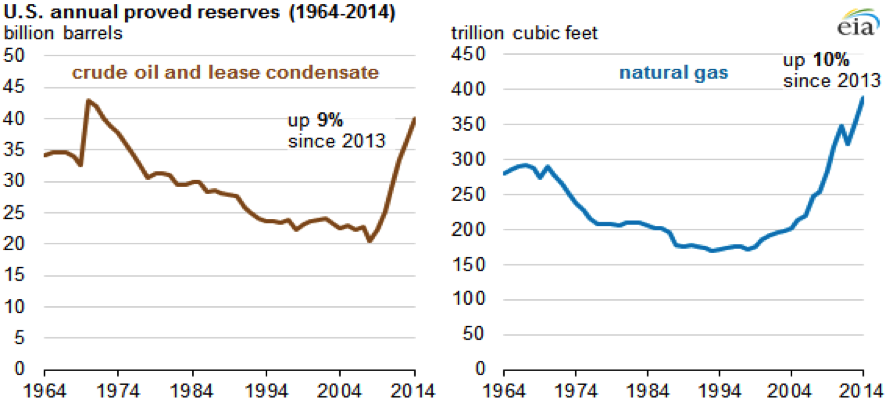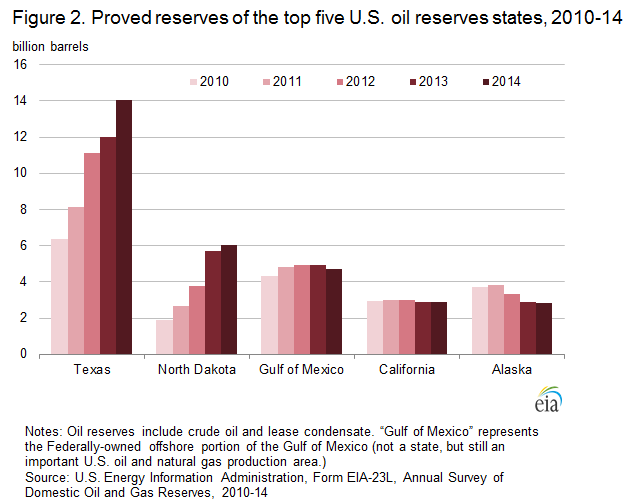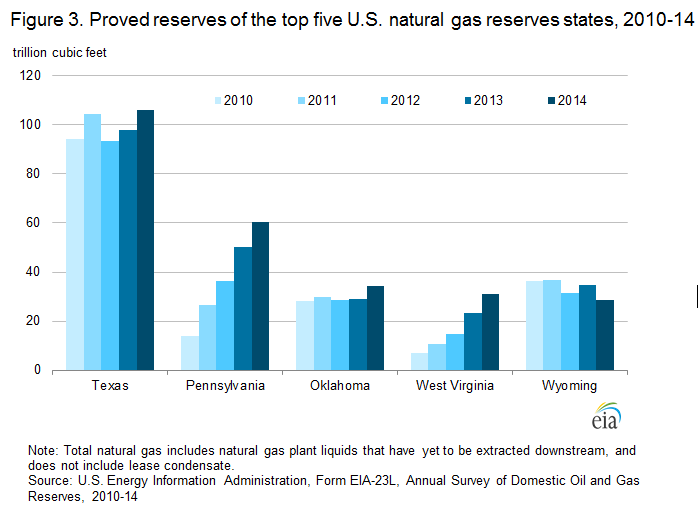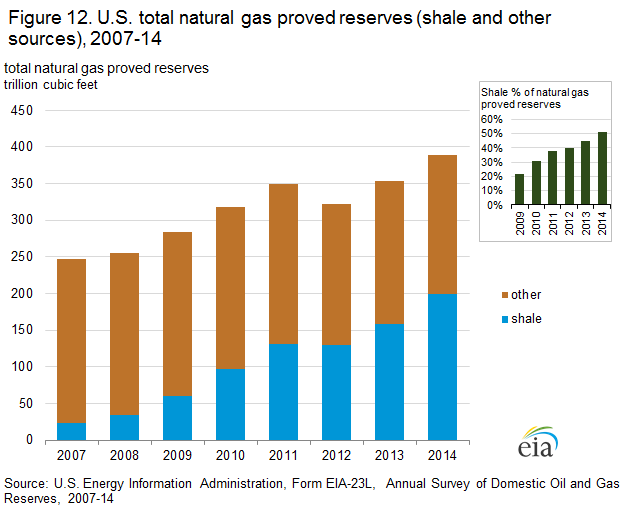The Energy Information Administration recently released its U.S. Crude Oil and Natural Gas Proved Reserves Report showing that oil and natural gas proved reserves continue to increase. U.S. crude oil and lease condensate proved reserves increased by 9 percent to 39.9 billion barrels in 2014, and natural gas proved reserves increased by 10 percent to 389 trillion cubic feet.[i] Crude oil and lease condensate proved reserves are now at the highest level since 1972 and natural gas proved reserves are the highest ever.[ii]

Source: EIA, http://www.eia.gov/todayinenergy/detail.cfm?id=23932
Proved reserves of oil and natural gas are volumes that geologic and engineering data demonstrate with reasonable certainty to be recoverable under existing economic and operating conditions. Because proved reserves depend on economic factors, they increase and/or decrease as prices and extraction costs change. Proved reserves are developed from technically recoverable resources, of which the United States has an immense amount.[iii] According to the EIA report, the United States has recoverable oil resources that are 36 times larger than its proved oil reserves and recoverable natural gas resources that are 7 times larger than its proved natural gas reserves for 2014.
Proved Reserves of Oil and Lease Condensates
Texas had the largest increase in proved reserves of crude oil and lease condensate, 2,054 million barrels, representing 60 percent of the nation’s total net increase in 2014, coming mainly from tight oil plays (e.g., Wolfcamp, Bone Spring) in the Permian Basin and the Eagle Ford Shale play. North Dakota had the second-largest increase, 362 million barrels, representing 11 percent of the nation’s net increase in 2014, mostly from the Bakken tight oil play in the Williston Basin. These two states are the largest crude oil and lease condensate reserve and production states in the nation. New Mexico had the third-largest increase in crude oil and lease condensate proved reserves in 2014, benefitting from the same Permian Basin developments as Texas. Colorado had the fourth-largest increase in crude oil and lease condensate reserves in 2014, from the Niobrara/Codell tight oil play in the Denver Basin.

Source: EIA, http://www.eia.gov/naturalgas/crudeoilreserves/index.cfm
Tight oil plays, mostly from shale formations, accounted for 33 percent of all the crude oil and lease condensate proved reserves. Most (95 percent) U.S. tight oil proved reserves in 2014 came from six tight oil plays. The Bakken/Three Forks play in the Williston Basin retained its rank as the largest tight oil play in the United States in 2014, followed by the Eagle Ford.
Proved Reserves of Natural Gas
Proved natural gas reserves increased in four of the top five U.S. gas reserves states (Texas, Pennsylvania, Oklahoma, and West Virginia) in 2014. Pennsylvania, had the largest net increase in natural gas proved reserves (10.4 trillion cubic feet) in 2014, but remained the second largest state in natural gas reserves—second to Texas. Texas added the second-highest volume of natural gas proved reserves (8.0 trillion cubic feet) in 2014, followed by West Virginia (7.9 trillion cubic feet), Oklahoma (5.4 trillion cubic feet).
Ohio added almost 4 trillion cubic feet of natural gas proved reserves in 2014, more than doubling its natural gas proved reserves. Ohio approved 2,087 Utica shale permits, of which, 1,648 Utica wells have been drilled and 1,119 Utica wells are producing. According to the state, natural gas production increased by 126 percent, from 287 billion cubic feet of natural gas for the first nine months in 2014 to 651 billion cubic feet for the first nine months of 2015.[iv]
West Virginia added enough Marcellus natural gas proved reserves to surpass Wyoming and Colorado to become the fourth-largest natural gas reserves state, ranking behind Oklahoma. Idaho reported proved natural gas reserves for the first time in 2014.

Source: EIA, http://www.eia.gov/naturalgas/crudeoilreserves/index.cfm
Natural gas reserves in shale plays contributed more than half to total natural gas proved reserves in 2014. Proved reserves of shale natural gas increased from 159.1 trillion cubic feet in 2013 to 199.7 trillion cubic feet in 2014 (an increase of 40.6 trillion cubic feet)—25 percent higher than in 2013. The share of shale gas compared with total natural gas proved reserves increased from 45 percent in 2013 to 51 percent in 2014.

Source: EIA, http://www.eia.gov/naturalgas/crudeoilreserves/index.cfm
Conclusion
Proved reserves of oil and natural gas are ever increasing in the United States, mainly due to the shale revolution that allows oil companies to produce oil and natural gas from shale formations economically using hydraulic fracturing and horizontal drilling technology. Proved natural gas reserves from shale formations now constitute over half of all the proved natural gas reserves in the United States and proved oil reserves from tight oil formations, mainly shale plays, constitute a third of the proved oil reserves in 2014. While natural gas reserves reached another record in 2014 and oil reserves were the highest since 1972, the technically recoverable resources from which they came are enormous and will continue to supply proved reserves for Americans for decades to come.
[i] Energy Information Administration, U.S. Crude Oil and Natural Gas Proved Reserves, November 23, 2015, http://www.eia.gov/naturalgas/crudeoilreserves/index.cfm
[ii] Energy Information Administration, U.S. oil and natural gas reserves both increase in 2014, November 23, 2015, http://www.eia.gov/todayinenergy/detail.cfm?id=23932
[iii] Institute for Energy Research, North American Energy Inventory, December 2011, http://www.energyforamerica.org/wp-content/uploads/2012/06/Energy-InventoryFINAL.pdf
[iv] Akron Beacon Journal, Production continues to grow from gas-oil wells in Ohio’s Utica shale, December 3, 2015, http://www.ohio.com/news/local/production-continues-to-grow-from-gas-oil-wells-in-ohio-s-utica-shale-1.645081



